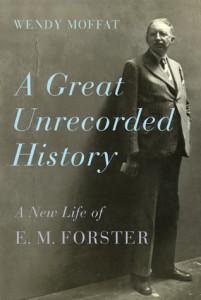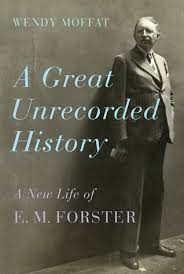 A Great Unrecorded History: A New Life
A Great Unrecorded History: A New Life
of E. M. Forster
by Wendy Moffat
Farrar, Straus and Giroux
404 pages, $32.50
WAS E. M. FORSTER a coward? A case could be made. He was deferential to a domineering mother, fearing her censure of his gay-themed writing as well as the men he loved, regretting he was unable to become the “authoritative male” who might have lessened her depression after the early death of his father. Short of falsely declaring himself to be a conscientious objector, he did everything he could to avoid conscription into the British Army during World War I until a medical board declared him unfit to fight. A draft of Maurice, his overtly homosexual novel, was finished in 1914. For the rest of his life Forster circulated copies of the manuscript among friends and fellow writers but turned a deaf ear to their pleas that he publish the book. It did not appear until 1971, a year after his death. And then there is the famous statement in his 1938 essay, “What I Believe”: “I hate the idea of dying for a cause, and if I had to choose between betraying my country and betraying my friend, I hope I should have the guts to betray my country.”
Forster didn’t know if his repudiation of force and violence was due to courage or cowardice. He knew only that personal relationships are more important than causes. In her splendid new biography, Wendy Moffat demonstrates that in his life and writing E. M. Forster rejected the premise that courage was synonymous with the power of one person or one country over another. Instead, he worked out a “private ethic” of friendship that enabled him to survive in a century of homophobia and war.
Forster did more than survive. He wrote two of the major novels of the 20th century, Howards End and A Passage to India. The years leading up to these books have been well documented, especially in P. N. Furbank’s excellent authorized biography, which appeared in 1977. What’s new about Moffat’s contribution to our understanding of Forster is suggested by her title: the “unrecorded history” is that of Forster the gay man. The two most engrossing sections of this book deal with years in which Forster was not doing much writing. By the start of the First World War, he had completed five of his six novels. Weary of writing fiction about men, women, and marriage, he felt his career as a writer was over. Although not a pacifist, he refused to enlist, leaving himself open to attacks on his manhood and patriotism. He was “leading the life of a little girl,” he told a friend, as long as he remained at home, which meant both his mother and England. Suddenly that changed. In 1915 Forester went to Alexandria as a Red Cross volunteer.
Moffat wonderfully evokes the setting—ancient, sensual, colonial—in which Forster, by force of will, created himself as a gay man who could take pleasure in his body and take exquisite care of the men he loved. Forster had sex for the first time at age 37, anonymously, with a soldier on a beach near the hospital where he worked. In Alexandria he fell in love with Mohammed el Adl, a handsome young Egyptian tram conductor, who reciprocated his affection until his early death from consumption. Forster’s job was to listen to wounded soldiers and write reports of their stories, which would be sent to the Red Cross and their families. With his own gay identity emerging, Forster was sensitive enough to notice that some of the stories he heard were about the love of young working-class men for each other, love often tragically curtailed by the battlefield death of a partner. He had discovered a part of the “great unrecorded history” of gay men. The discovery would transform his life: he knew he was part of a multitude.
After Forster published his final novel, A Passage to India, in 1924, he accepted that the fiction he was inclined to write would remain unpublishable because of its gay content. Forster more than made up for this in his sexual life. Between the wars he engaged in a number of affairs with working-class men in London and with servants in India. Although not exactly exploitative, these affairs, with their social and economic disparities, seem to have been futile indulgences. Then, in 1930, Forster met Bob Buckingham, the married policeman who remained his lover until his death. But what emerges in the later chapters of Moffat’s biography is not a story of clandestine trysts. Forster shared Bob with his wife May with surprising openness. The three of them came to hold each other in mutual love and esteem, giving the lie to narrow views of what’s possible in marriage.
For the last thirty years of his life, Forster was a famous writer and public figure. He was never openly gay, and the general public was comfortable classifying him as a bachelor don, but as Moffat describes his friendships, his travels, and his life with Bob Buckingham, we realize how much of his life belonged to that undisclosed subculture that flourished in the mid-20th century. Nowhere is this more evident than when Forster traveled to the U.S. after the war. Publicly, he made speeches. Privately, he spent time with younger gay writers and artists—Glenway Wescott, Lincoln Kirstein, Paul Cadmus, George Platt Lynes, Auden, and Isherwood—and their lovers. Many of these men were strongly influenced by Forster’s work, especially “What I Believe,” before they met him in person. They revered this man who began publishing before some of them were born. Reading this section of Moffat’s book, we are struck by how well known this once hidden period of gay history has become.
Moffat takes Forster’s later years out of his fusty rooms at King’s College, Cambridge, where he was safely consigned by literary critics through the early 1970’s, and places him at the center of a significant moment in gay history in the decades after World War II. This history contains a great deal of sexual activity. It also contains stories of artistic achievement and collaboration, shared love, and networks of mutual support. When Forster wrote a biography of British historian and political activist Goldsworthy Lowes Dickinson in 1934, he knew he could not be explicit about his friend’s homosexuality, but he filled the book with enough clues that the truth of his life would survive among perceptive readers. With Wendy’s Moffat’s beautifully written biography, the truth of E. M. Forster’s brave life will never again be unrecorded.






